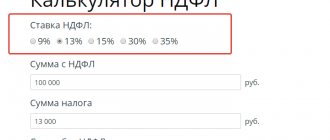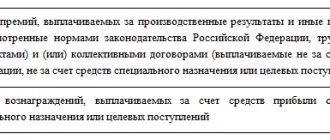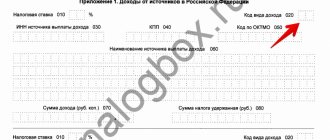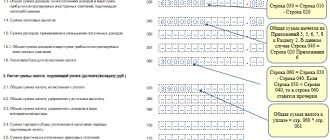In order to reduce the tax burden on Russian citizens, the state uses a number of mechanisms that make it possible to legally reduce the tax base and, accordingly, the amount of tax.
One such mechanism is the provision of tax deductions. These are statutory amounts that are deducted from taxable income. These benefits may concern not only earnings, but also other payments received in cash or property (in kind) form - for example, material assistance.
In the 2-NDFL certificate, as well as in the tax and accounting registers reflecting the income and expenses of individuals, these deductions are indicated using the corresponding numeric codes.
What types of income can be deducted?
Certificate 2-NDFL indicates all types of income that the taxpayer received in a specific reporting period, including:
- salary at the main and additional places of work;
- interest on deposits, income from transactions with securities;
- material assistance in cash or property (in kind);
- income from foreign currency transactions;
- winnings from bookmakers, casinos, from participation in lotteries and drawings, received in cash or property (for example, prizes);
- income from rental of vehicles and real estate;
- royalties, dividends, etc.
Tax deductions can be provided for different types of income. To avoid confusion when preparing a 2-NDFL certificate, as well as tax and accounting registers reflecting the income and expenses of individuals, an individual code is assigned to each type of income and tax deduction.
What does code 503 mean in the 2-NDFL certificate?
In order to get an answer to the question of what code 503 means in the 2-NDFL certificate, let’s turn to tax legislation. According to the current Art. No. 217 of the Tax Code of the Russian Federation, any income of citizens living and working in the country is taxed and must be recorded in the regulated certificate Form 2 of personal income tax.
It contains information about all possible sources of income, wages and deductions. As a rule, 2-NDFL is issued by the employer for a period of up to 1 year and is filled out on the basis of strictly established regulations. The form has a clearly defined structure and coding, containing information on income data, as well as the amounts of individual deductions and calculations. Each code is approved by the Federal Tax Service of the Russian Federation and is used to fill out data by individuals under certain conditions. They are located on the lines of the table in section No. 3 next to information about the corresponding income.
What does tax deduction code 503 mean?
Financial assistance paid by an employer to its employees (including former employees retired due to age or disability) is one of the types of income for which a tax deduction is provided. Its amount is 4,000 rubles per year per employee, which is provided for in clause 18 of Art. 217 of the Russian Tax Code.
The deduction is indicated in the 2-NDFL certificate, as well as in the relevant tax and accounting documents, using code 503.
Let’s assume that an employee of an enterprise received financial assistance from him in the amount of 15,000 rubles. In this case, this amount will be reflected in the 2-NDFL certificate using code 2760, and the amount of the due deduction (4,000 rubles) will be reflected under code 503. The calculation of the taxable amount in this case will look like this:
15,000-4,000 = 11,000 rubles
The amount under code 503 is a fixed amount that does not depend on the amount of financial assistance. It can be used several times a year, but only within the established limit.
For example, if a person received financial assistance in April in the amount of 1,500 rubles, in August - 2,000 rubles, and in November - 6,000 rubles, then in the first and second cases the amounts will be fully discounted, and in the third, the remaining 500 rubles will be deducted from the financial assistance:
4000 - 1500 - 2000 = 500 rubles
Consequently, income tax will be withheld only from November financial assistance, and the taxable amount will be 5,500 rubles.
Features of tax deductions
A tax deduction is an amount of money that allows you to reduce the amount of income, which in turn is subject to taxes. In certain cases, a tax deduction refers to a partial refund of funds that were previously paid in the form of taxes on the income of an individual. For example, purchasing an apartment, medical expenses or training. In principle, tax should not be withdrawn from the amounts you spent on the above actions. Therefore, all necessary documents are completed, and funds previously withdrawn from your wages are returned.
It must also be remembered that not the entire amount of expenses incurred is subject to refund, but only the amount of tax that was calculated and withheld from these funds.
Types of deductions:
- Standard deductions;
- Social deductions;
- Property deductions;
- Professional deductions.
How to correctly determine the amount of deduction? Everything is quite simple. For example, you receive a salary of 50,000 rubles. Naturally, your salary is taxed at 13%. During the month you spent 10,000 rubles on training. Accordingly, the refund involves the amount of taxes on the amount of 10,000 rubles. This turns out to be 1300 rubles.
What is the difference between deduction codes 503 and 508
It is worth noting that deduction code 503 has nothing to do with financial assistance paid on the occasion of the birth of a child. This is another type of income, which is reflected in the 2-NDFL certificate, as well as in the relevant tax and accounting documents, using code 2762.
In this case, the tax is calculated differently, and the corresponding tax deduction is indicated by code 508.
Thus, when filling out the 2-NDFL certificate, as well as the corresponding accounting and tax documentation, you need to remember the following:
- income code 2760 denotes financial assistance paid by an employer to its employees (including former employees retired due to age or disability), and is used only in conjunction with deduction code 503;
- income code 2762 denotes financial assistance paid by the employer on the occasion of the birth of a child, and is used only in conjunction with deduction code 508.
question What deduction is indicated in the 2-NDFL certificate under code 503?
An employee of an enterprise has reached retirement age and is about to retire. Is the employer required by law to provide him with a financial lump sum payment upon retirement? How is this payment reflected in the certificate in Form 2-NDFL and how is it calculated. Is this payment taxable? Is the income received by an employee really reflected under code 503 or is a tax deduction indicated there?
This is interesting: Transport tax « Avtoguru.pro
In accordance with current legislation, all income received by citizens of the Russian Federation must be strictly reflected in the financial statements and a tax must be imposed on them, which must be reflected in the form 2-NDFL. This certificate is issued for the reporting period and covers one year. To fill out the certificate, state regulations are used. For the convenience of reflecting in the certificate the items of income and taxes deducted from them, a special coding approved by the Federal Tax Service of the Russian Federation is provided. Such codes are reflected in section 3 of the certificate next to direct income or tax.
Under code 503, reporting reflects income taxed at 13%. This code corresponds to the item of deductions from the amount of financial assistance allocated by the employer for its current or former employees dismissed upon reaching retirement age and officially retiring. Another case for paying a lump sum benefit may be retirement due to disability.
It is worth noting that the law does not regulate the employer’s obligation to pay such compensation (assistance). It appears on a voluntary basis.
The 2-NDFL certificate simultaneously reflects the income received by the employee (material assistance) under code 2760, and the tax deduction from the assistance provided under code 503.
According to the tax code, the financial assistance in question has a fixed amount, which is not taxed. It is maximum 4 thousand rubles. Consequently, if the assigned assistance exceeds the specified amount, then that part of the assistance that exceeds the amount not subject to taxation will be taxed at a rate of 13%.
Consequently, if financial assistance is less than the tax-free minimum, then this amount may not be reflected in the certificate at all. However, if assistance is assigned in a larger amount, then it is necessary to reflect both the assigned amount and make tax deductions from the assistance allocated by the employer.
The procedure for taxing the income of citizens of the Russian Federation, as well as the rules for reflecting them in the 2-NDFL certificate, are regulated by Article 217 of the Tax Code of the Russian Federation.
The amount of fixed financial assistance, established by code 503, which is not subject to taxation, is determined by paragraphs 8 and 28 of Article 217 of the Tax Code.
Documents to confirm the right to deduct
The decision to provide an employee with financial assistance is formalized by order of the head of the enterprise. The grounds for issuing an order may be:
- employee's personal statement;
- relevant provisions of the employment or collective agreement;
- internal regulatory document regulating the procedure for providing financial assistance to employees of the enterprise.
No additional documentary evidence is required to receive a deduction under code 503. This benefit is provided for at the legislative level and is set out in paragraph 28 of Art. 217 of the Russian Tax Code.
-Accordingly, if an employee received financial assistance, then a deduction in the amount of 4,000 rubles per year is provided automatically.
The procedure for filling out the 2-NDFL certificate
The procedure for filling out the paper in question is as follows:
- First, information about the employer is entered.
- Next, data about the entity receiving financial assistance is reflected.
- A list of a person's income that is subject to taxation is indicated.
- A list of deductions provided to citizens is determined. This section of 2-NDFL indicates deduction 503.
- The final section specifies the total amount of funds to be paid to the budget.
This is interesting: Print out a receipt for payment of a traffic police fine
Information on deduction code 503 is entered into the 2-NDFL certificate in the standard manner. The main feature of the considered cipher is the procedure for calculating the deduction based on it.
Deduction code 503 when filling out the 3-NDFL declaration
Where to include this or that deduction in the personal income tax return is a question that often arises among citizens who independently fill out the report. In certificates issued by employers, all deductions are assigned digital codes that are not included in 3-NDFL.
- in full - payments in the event of the death of an employee, former employee or family members, assistance to victims of terrorist attacks, payments in connection with natural disasters;
- in the amount of 50 thousand rubles - payments for the birth or adoption of a child (within one year);
- up to 4 thousand rubles - the amount of financial assistance for other reasons.
Usage example
Income code 503 appears on the income tax certificate if the amount of support itself is greater than the amount of the deduction.
For example, over the course of a year, the company helped an employee with a difficult financial situation several times: first it paid him 4,000, then another 4,000, and at the end of the year – 5,000. In total, the employer helped him in the amount of 13,000 rubles.
In the certificate for the year, personal income tax on these payments will be: (13,000 – 4,000) × 13% = 1,170 rubles.
The income code will be 2760 - 13,000. The deduction code will be 503, in the amount of 4,000.
Note! If a person works for an individual entrepreneur, then the general rules apply. Individual entrepreneurs are the same employers and tax agents as organizations: they are required to calculate taxes on salaries and other income for personnel and submit reports.
Moreover, it does not matter what mode the individual entrepreneur operates in: simplified tax system, “imputation” or the general system. Even if the entrepreneur himself does not pay income tax, he is obliged to pay it instead of his employees in accordance with Article 226 of the Tax Code of the Russian Federation.
Other deduction codes in 2-NDFL
There are other codes listed in the list attached to this Order of the Federal Tax Service. To make it more convenient to consider them, we present the values in the table, but first we will take a closer look at the most frequently encountered codes.
327 deduction code in 2-NDFL is possible only when transferring insurance premiums or contributions to the Pension Fund of Russia - both for yourself and for relatives. Deductions are also possible for voluntary transfers to private pension funds. The maximum tax-free amount is 120 thousand rubles.
Deduction code 508 in the 2-NDFL certificate is very similar in meaning to code 503, but there is a key difference in the reason for paying financial assistance: here income is not taxed only on the amount paid to the employee in connection with the birth of a child. The benefit amount is no more than 50 thousand rubles for each child.
The number 529 is also often found. In fact, this code was excluded from the database a very long time ago - it was replaced by the code 311.
| Code | In connection with what and to whom it is given | Sum |
| 104 | Socially vulnerable citizens: disabled people, WWII veterans, Heroes of the USSR, etc. | 500 rubles |
| 105 | Persons who became disabled due to accidents in the USSR (Chernobyl, Mayak Production Association, etc.), as well as military personnel who became disabled as a result of hostilities | 3000 rubles |
| 311 | In connection with the costs of building or purchasing a home | 2 million rubles |
| 321 | Expenses for full-time education of children | 50,000 rubles |
| 403 | T.N. “professional deduction” associated with the fulfillment of indirect conditions of a civil contract: for example, expenses for the purchase of materials for construction, transportation expenses, etc. | The amount paid by the customer as compensation for indirect costs |
2-NDFL: income code 2002 and income code 2003
When tax authorities updated the lists of income codes and deduction codes in 2021, bonuses now have their own codes:
- code 2002 - in the 2-NDFL certificate it is used for bonuses paid for production results and other similar indicators provided for by the norms of the legislation of the Russian Federation, employment agreements (contracts) and/or a collective agreement (paid not at the expense of the organization’s profit, not at the expense of special funds appointments or targeted revenues);
- code 2003 - for remunerations not related to the performance of job duties, paid from the organization’s profits, special-purpose funds or targeted revenues.
Where is the code indicated?
Depending on version 2 of personal income tax code 503 is written:
- in machine-oriented form.
- in a traditional table.
Important! The deduction for financial assistance reduces personal income tax, so it is required to be reflected in 2 personal income taxes.
The 503 deduction is used when calculating financial assistance. And financial assistance is paid after:
- the employee submits an application;
- issuing an order to the company to pay the support amount.
The Tax Code of the Russian Federation provides for different types of financial assistance in terms of their taxation:
| Help | How to release |
| Death of the employee or a member of his family | 100% |
| Emergency | 100% |
| Birth of a child | Amount of up to RUB 50,000 paid in the first year of the event |
| Vacation | Not released |
| Other situations | 4,000 rub. in a year |
And in the order of the Federal Tax Service there are separate codes for the following situations:
- deduction from financial assistance for disabled people - code 506;
- from assistance at the birth of a child - code 508;
- from financial aid – 503.
But according to the opinion of the Federal Tax Service and accountants, code 503 reflects precisely a deduction in the amount of 4,000 rubles. for all other situations. And 100% deductions are not shown at all in personal income tax documents, since no tax is paid on this income anyway.
Important! Personal income tax reporting does not reflect income and deductions if no tax is paid on them. If you paid an employee up to 4,000 rubles in assistance for a whole year. inclusive, then it does not need to be included in either 2nd personal income tax or 6th personal income tax, since the deduction reduces this payment to zero.
Another interesting nuance: according to the Federal Tax Service, when paying an amount to an individual with whom the company did not enter into an employment contract, it is not necessary to submit a certificate for him. For example, a company provided support to a person with whom it collaborated for a short time under a civil partnership agreement.
How to fill out tax deductions in the 3-NDFL declaration?
This is acceptable in situations where, in the year of collecting the full package of documents required for such a deduction, a person applies to the Federal Tax Service for a notification of the right to deduction and, on the basis of this notification and a similar document received annually in subsequent years, returns the tax at work. If he uses only this algorithm of actions to return personal income tax on this basis, then he may not need a 3-NDFL declaration to receive a property deduction in connection with the purchase of a home. Home / Taxes / Personal Income Tax / How to fill out the codes in the 3-NDFL declaration 08.01. 2020, Sashka Bukashka When filling out the 3-NDFL declaration, codes are used.
How to reflect deduction code 501 in 3-NDFL
The amount and type of all income that the employer paid to the employee is reflected in the 2-NDFL certificate. It also indicates the deductions provided. Each type of income and deduction has its own code, a full list of which is presented in the Order of the Federal Tax Service dated September 10, 2015 No. ММВ-7-11/ [email protected]
Code 501 marks a deduction from the cost of gifts. For example, an organization gave an employee a gift on March 8 or his birthday and is obliged to reflect this in the certificate.
.
Important! According to clause 28 of Article 217 of the Tax Code, gifts worth up to 4,000 rubles. are not subject to personal income tax. So, 4,000 rubles. - This is the maximum deduction amount. If the gift is more expensive, you need to pay tax on the difference.
In 3-NDFL, tax-free income is entered in Appendix 4. For gifts, line 020 is provided on the sheet.
When working in the Declaration program, tax deduction code 501 in 3-NDFL for 2021 is reflected in the income tab. How to do it:
- Create a new source of income according to the data from the 2-NDFL certificate.
- Transfer monthly information about income received and deductions from the certificate. Income in the form of gifts corresponds to code 2720.
- Enter the withheld tax amount (it is indicated in the certificate, already taking into account the deduction provided).
Features of calculating deductions using code 503
In conditions where the amount of financial assistance upon dismissal of a subject from a position due to retirement does not exceed 4 thousand rubles, it does not have to be reflected in the 2-NDFL form.
If the amount of funds is more than 4 thousand rubles, it becomes necessary to make appropriate calculations and deductions.
Next, 4,000 will be deducted from the total amount of money provided, and the remainder will become the person’s taxable income.
For example: L. O. Kovrigin resigns from his position as an electrician due to reaching retirement age. In this regard, the employer provides him with financial support in the amount of 10,000 rubles.
The calculations will look like this:
- 10.000 – 4000 = 6000 rub. – amount of funds subject to tax;
- 6000 * 13% = 780 rub. – tax amount;
- 10.000 – 780 = 9220 rub. – funds that Kovrigin will receive upon retirement.
Thus, deduction 503 in the 2-NDFL certificate is a special code for designating financial assistance upon the occurrence of a certain event. Employers need to familiarize themselves with the procedure for issuing a 2-NDFL certificate, as well as the specifics of entering the amount for the code in question into the document.







